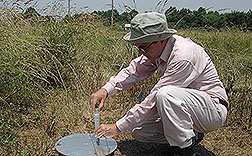This page has been archived and is being provided for reference purposes only. The page is no longer being updated, and therefore, links on the page may be invalid.
|
Read the magazine story to find out more. |
|
|
Capturing Carbon a Key Benefit of No-Till Soil Management
By Sharon DurhamApril 13, 2005
No-till soil management can play an important role in keeping carbon in the soil, rather than allowing it to escape into the atmosphere as carbon dioxide, according to a cooperative study by Agricultural Research Service (ARS) and Brazilian scientists at Beltsville, Md.
Capturing carbon and other substances in the soil keeps them from contributing to "global warming" as greenhouse gases.
Brazilian scientist Helvecio De-Polli worked on the study from 2002-2004 with ARS soil scientist Gregory McCarty and others at ARS' Environmental Quality Laboratory (EQL) in Beltsville. De-Polli works for the Brazilian Ministry of Agriculture, Livestock and Food Supply's Empresa Brasileira de Pesquisa Agropecuaria (Embrapa).
The soil carbon study was done at a field site where researchers had conducted a 10-year tillage experiment comparing no-till farming with cultivation by plowing. Soil microbial biomass and carbon stocks stored in the soil were measured at the end of the 10-year period. Also, emissions of methane, carbon dioxide and nitrous oxide from the soil were monitored for an entire year. These three are the most important "greenhouse gases" exchanged between agricultural systems and the atmosphere.
Microbes are responsible for processes in the soil that produce these gases. A complete understanding of greenhouse gas emissions is important to development of methods to capture soil carbon, according to De-Polli.
His work shows that no-till farming can play a positive role in mitigating greenhouse gases by capturing carbon that's stored in the soil in plant tissues which remain in the field after the crop is harvested.
Read more about this research in the April issue of Agricultural Research magazine.
ARS is the U.S. Department of Agriculture's chief scientific research agency.

